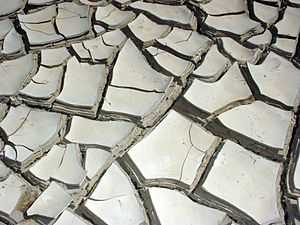Desiccation

Desiccation is the state of extreme dryness, or the process of extreme drying. A desiccant is a hygroscopic (attracts and holds water) substance that induces or sustains such a state in its local vicinity in a moderately sealed container.
Chemistry

A desiccator is a heavy glass or plastic container used in practical chemistry for making or keeping small amounts of materials very dry. The material is placed on a shelf, and a drying agent or desiccant, such as dry silica gel or anhydrous sodium hydroxide, is placed below the shelf.
Often some sort of humidity indicator is included in the desiccator to show, by color changes, the level of humidity. These indicators are in the form of indicator plugs or indicator cards. The active chemical is cobalt chloride (CoCl2). Anhydrous cobalt chloride is blue. When it bonds with two water molecules, (CoCl2•2H2O), it turns purple. Further hydration results in the pink hexaaquacobalt(II) chloride complex [Co(H2O)6]2+.
Biology and ecology
In biology and ecology, desiccation refers to the drying out of a living organism, such as when aquatic animals are taken out of water, slugs are exposed to salt, or when plants are exposed to sunlight or drought. Ecologists frequently study and assess various organisms' susceptibility to desiccation. For example, in the study performed by Erkut et al., [1] the investigators found that Caenorhabditis elegans dauer is a true anhydrobiote that can withstand extreme desiccation and that the basis of this ability is founded in the metabolism of trehalose.
Broadcasting
In broadcast engineering, a desiccator may be used to pressurize the feedline of a high-power transmitter. Because it carries a large amount of energy from the transmitter to the antenna, the feedline must have low dielectric losses. Because it must also be lightweight so as not to overload the radio tower, air is often used as the dielectric. Since moisture can condense in these lines, desiccated air or nitrogen gas is pumped in. This pressure also keeps water or other dampness from coming in the line at any point along its length.

See also
References
- ↑ Erkut, Cihan (9 August 2011). "Trehalose Renders the Dauer Larva of Caenorhabditis elegans Resistant to Extreme Desiccation". Current Biology 21 (15): 1331–1336. doi:10.1016/j.cub.2011.06.064. PMID 21782434. Retrieved 5 November 2014.